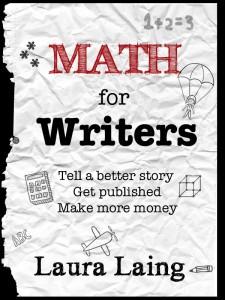Make Numbers Come Alive by Laura Laing
True confession: I have a huge math phobia. My dad’s a math professor, but no matter how he explained complicated concepts, it didn’t make sense to me. In college, I finally got interested in math when a teacher talked about in relation to practical matters. Suddenly math wasn’t about how fast the trains were going but how to figure out our earning potential or plan a road trip. Cool! When I heard about Laura Laing’s new book, Math for Writers: Tell a Better Story, Get Published, Make More Money, I got excited: finally a book that talks about why math matters to writers. Yeah! So read on to learn how you can use numbers to tell a better story and then enter to win a signed copy of Laura’s new book! -Rochelle, the Write Now! Coach
 Make Numbers Come Alive By Laura Laing
Make Numbers Come Alive By Laura Laing
This is an excerpt from Laura Laing’s Math for Writers: Tell a Better Story, Get Published, Make More Money. In this section from chapter 1, Laura explains how writers can get creative with numbers, while helping readers better understand their significance.
Think for a moment about how you read news stories, like this totally made up one:
By the end of its first year, Jumpin’ Jack’s Pizza Joint had served 27,400 patrons, thanks to its premier location on The Boulevard.
Be honest. Did you read it this way?
By the end of its first year, Jumpin’ Jack’s Pizza Joint had served blah-blah patrons, thanks to its premier location on The Boulevard.
If so, you’re not alone. Raw data doesn’t always further the story. See, as writers, we’re paid to clarify the information, not just dump numbers in just the way the source gives ’em to us.
Fact is, most people do not have a spot-on understanding of really large or really small numbers. You can count on your readers appreciating a few simple calculations that can help show the importance of the data—not just tell it straight out.
Jack has served 27,400 customers in his first year at his new location. That’s a lot of people—but what does it mean?
You can express this value in a variety of different ways.
Approximately 2,740 10-top tables
If you’ve ever worked in the restaurant business, you know that a 10-top is a table that seats 10 people. (A 2-top seats 2 people, a 4-top seats 4, and so on, and so on.) The math here is pretty darned simple: just divide 27,400 by 10 to get 2,740 10-top tables.
About 75 customers every single day, including weekends and holidays
This little translation is a bit less creative, but pretty powerful. The math is super easy. Just divide the number of customers by the number of days in a year:
27,400 ÷ 365 ≈ 75.07
A part of a person won’t order pizza, so round down to 75.
While this is a really practical number, the writing can create even more of a picture.
On average 75 customers place an order at Jumpin’ Jack’s Pizza Joint every single day of the year.
Close to a 10-mile-long, single-file line
For really visual readers, offering a vivid image is a great way to make sure that numbers hit their mark. Be sure, though, that what you’re offering makes sense to the story.
In this case, getting in line for really good pizza is realistic. So why not think about how long the line would be if all of the customers queued up?
This is where a little creativity is necessary. Research by social scientists shows that our preferred personal space with friends is 1.5 to 4 feet. When around strangers, we may want much more than a 4-foot bubble. But standing in a single-file line means being a little more up-close-and-personal than that. So, it makes sense that most people are probably going to stand about 2 feet from each other. In other words, for every 1 person in line, the line will be 2 feet long.
Then I looked up the number of feet in a mile (5,280) and divided by 2. Why 2? Because I wanted to know how many 2-foot segments would fit into 1 mile.
5,280 ÷ 2 = 2,640
What this means, in essence, is that a single-file line of 2,640 people is 1 mile long. So how many miles is a single-file line of 27,400 people? Divide again.
27,400 ÷ 2,640 ≈ 10.38
Yep, if you lined up 27,400 people, single file, giving each of them a 2-foot space to stand in, you’d have a line more than 10 miles long.
If Jumpin’ Jack’s has been dealing with long lines, this way of describing the numbers furthers the story:
For months, Jack has been managing long lines of customers waiting to be served or to place take-out orders. In fact if all of his customers lined up, single-file, by the end of the first year this line would be more than 10 miles long—or the distance from his current location to the new one.
See what I’ve done there? The line metaphor works great, because it brings in another aspect to the story—that the new location is so busy, lines form outside regularly. For local readers, the metaphor is made even more meaningful by giving it some geographical context.
A word of warning: when you get creative, you run the risk of distorting the numbers—and misleading the readers. For example, if I decided that each person in a single-file line needed 5 feet of personal space, the imaginary line for pizza would be 25 miles long. But that’s not really an accurate representation, is it? A little bit of research pointed me to a 2-foot bubble for each person in line—a much better estimation.
But although the just-right comparison can work well, the less-than-perfect comparison often falls flat and adds yet more confusion to what may be an already difficult story. As the writer, you should include the most effective analogies in your story. Test your idea on a friend or family member to see if it makes sense. Your editor’s feedback may help you refine this illustration. Or you may need to push back, if your editor wants to change your comparison to something misleading or difficult to understand. If you go this route:
- Make sure the image fits the story.
- Make sure your readers can picture the references.
- Avoid cliché images, like dollar bills placed end to end.
- Don’t add even more numbers with the image.
- Don’t repeat and image, like 23 football fields placed end to end. It’s hard enough for a person to imagine the size of a football field. But to imagine 23 fields? That’s asking too much of your readers.
Try it out. Some of your ideas will work, others won’t. Get creative with the comparisons and then do the math.
Your turn: Ask the author. What questions do you have about using math in your writing?
 About the author. Laura Laing is a freelance writer and the author of Math for Writers: Tell a Better Story, Get Published, Make More Money. Visit her website to check out her full virtual book tour and sign up for a free, live teleseminar just for writers who need math: http://www.mathforgrownups.com/math-for-writers-book-tour/
About the author. Laura Laing is a freelance writer and the author of Math for Writers: Tell a Better Story, Get Published, Make More Money. Visit her website to check out her full virtual book tour and sign up for a free, live teleseminar just for writers who need math: http://www.mathforgrownups.com/math-for-writers-book-tour/















Thanks so much for having me as a guest, Rochelle. I’d be happy to answer questions, if anyone has them.
Laura
So good to have you here, Laura!
Sounds like a great book. If I win the raffle, I will write about it for American Society of Journalists and Publishers, of which I am a member.